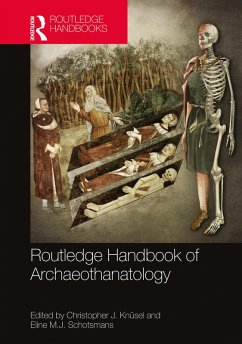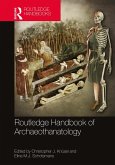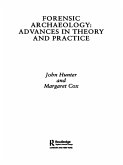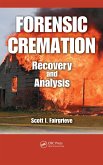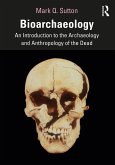The Routledge Handbook of Archaeothanatology (eBook, PDF)
Bioarchaeology of Mortuary Behaviour
Redaktion: Knüsel, Christopher J.; Schotsmans, Eline M. J.
44,95 €
44,95 €
inkl. MwSt.
Sofort per Download lieferbar

22 °P sammeln
44,95 €
Als Download kaufen

44,95 €
inkl. MwSt.
Sofort per Download lieferbar

22 °P sammeln
Jetzt verschenken
Alle Infos zum eBook verschenken
44,95 €
inkl. MwSt.
Sofort per Download lieferbar
Alle Infos zum eBook verschenken

22 °P sammeln
The Routledge Handbook of Archaeothanatology (eBook, PDF)
Bioarchaeology of Mortuary Behaviour
Redaktion: Knüsel, Christopher J.; Schotsmans, Eline M. J.
- Format: PDF
- Merkliste
- Auf die Merkliste
- Bewerten Bewerten
- Teilen
- Produkt teilen
- Produkterinnerung
- Produkterinnerung

Bitte loggen Sie sich zunächst in Ihr Kundenkonto ein oder registrieren Sie sich bei
bücher.de, um das eBook-Abo tolino select nutzen zu können.
Hier können Sie sich einloggen
Hier können Sie sich einloggen
Sie sind bereits eingeloggt. Klicken Sie auf 2. tolino select Abo, um fortzufahren.

Bitte loggen Sie sich zunächst in Ihr Kundenkonto ein oder registrieren Sie sich bei bücher.de, um das eBook-Abo tolino select nutzen zu können.
The Routledge Handbook of Archaeothanatology spans the gap between archaeology and biological anthropology, the field and laboratory, and between francophone and anglophone funerary archaeological approaches to the remains of the dead and the understanding of societies, past and present.
- Geräte: PC
- ohne Kopierschutz
- eBook Hilfe
- Größe: 64.5MB
Andere Kunden interessierten sich auch für
![The Routledge Handbook of Archaeothanatology (eBook, ePUB) The Routledge Handbook of Archaeothanatology (eBook, ePUB)]() The Routledge Handbook of Archaeothanatology (eBook, ePUB)44,95 €
The Routledge Handbook of Archaeothanatology (eBook, ePUB)44,95 €![The Routledge Handbook of Paleopathology (eBook, PDF) The Routledge Handbook of Paleopathology (eBook, PDF)]() The Routledge Handbook of Paleopathology (eBook, PDF)44,95 €
The Routledge Handbook of Paleopathology (eBook, PDF)44,95 €![Forensic Archaeology (eBook, PDF) Forensic Archaeology (eBook, PDF)]() Margaret CoxForensic Archaeology (eBook, PDF)40,95 €
Margaret CoxForensic Archaeology (eBook, PDF)40,95 €![Forensic Cremation Recovery and Analysis (eBook, PDF) Forensic Cremation Recovery and Analysis (eBook, PDF)]() Scott I. FairgrieveForensic Cremation Recovery and Analysis (eBook, PDF)137,95 €
Scott I. FairgrieveForensic Cremation Recovery and Analysis (eBook, PDF)137,95 €![The Archaeology of Human Bones (eBook, PDF) The Archaeology of Human Bones (eBook, PDF)]() Simon MaysThe Archaeology of Human Bones (eBook, PDF)40,95 €
Simon MaysThe Archaeology of Human Bones (eBook, PDF)40,95 €![Bioarchaeology (eBook, PDF) Bioarchaeology (eBook, PDF)]() Mark Q. SuttonBioarchaeology (eBook, PDF)37,95 €
Mark Q. SuttonBioarchaeology (eBook, PDF)37,95 €![Misanthropology (eBook, PDF) Misanthropology (eBook, PDF)]() Sean M. RaffertyMisanthropology (eBook, PDF)37,95 €
Sean M. RaffertyMisanthropology (eBook, PDF)37,95 €-
-
-
The Routledge Handbook of Archaeothanatology spans the gap between archaeology and biological anthropology, the field and laboratory, and between francophone and anglophone funerary archaeological approaches to the remains of the dead and the understanding of societies, past and present.
Dieser Download kann aus rechtlichen Gründen nur mit Rechnungsadresse in A, B, BG, CY, CZ, D, DK, EW, E, FIN, F, GR, HR, H, IRL, I, LT, L, LR, M, NL, PL, P, R, S, SLO, SK ausgeliefert werden.
Produktdetails
- Produktdetails
- Verlag: Taylor & Francis
- Seitenzahl: 768
- Erscheinungstermin: 28. April 2022
- Englisch
- ISBN-13: 9781351030618
- Artikelnr.: 63912008
- Verlag: Taylor & Francis
- Seitenzahl: 768
- Erscheinungstermin: 28. April 2022
- Englisch
- ISBN-13: 9781351030618
- Artikelnr.: 63912008
Christopher J. Knüsel is Professor of Biological Anthropology, University of Bordeaux, France. His research centres on the use of biological anthropological data within its archaeological context to address social relations in the past, including specifically violence and warfare and morphological changes linked to specialisation. With Martin J. Smith, he co-edited and contributed to The Routledge Handbook of the Bioarchaeology of Human Conflict (2014). Eline M.J. Schotsmans is a research fellow at the University of Bordeaux, France, and the University of Wollongong, Australia. Her research lies at the interface between archaeoanthropology and forensic sciences with a focus on mortuary sequences, preservation practices, taphonomy and method development through experimentation. Her positions in France, Belgium, the United Kingdom and Australia helped to broaden her perspective of francophone and anglophone funerary archaeological approaches.
Introduction: Archaeothanatology, funerary archaeology and bioarchaeology: perspectives on the long view of death and the dead Christopher J. Knüsel and Eline M.J. Schotsmans Part I: Archaeothanatology - methodological guidelines 1. Methodological guidelines for archaeothanatological practice Frédérique Blaizot 2. A tale of two worlds: Terminologies in archaeothanatology Bruno Boulestin 3. Words between two worlds: Collective graves and related issues in burial terminology Bruno Boulestin and Patrice Courtaud 4. Secondary cremation burials of past populations: Some methodological procedures for excavation, bone fragment identification and sex determination Germaine Depierre 5. The accompanying dead Bruno Boulestin 6. Denied funeral rites: The contribution of the archaeothanatological approach Aurore Schmitt Part II: Period-specific applications 7. Early primary burials: Evidence from Southwestern Asia Anne-marie Tillier 8. The earliest European burials Bruno Maureille 9. Beyond the formal analysis of funerary practices? Archaeothanatology as a reflexive tool for considering the role of the dead amongst the living: A Natufian case study Fanny Bocquentin 10. What can archaeothanatology add? A case study of new knowledge and theoretical implications in the re-study of Mesolithic burials in Sweden and Denmark Liv Nilsson Stutz 11. Neolithic burials of infants and children Mélie Le Roy and Stéphane Rottier 12. Defining collective burials: Three case studies Aurore Schmitt 13. Different burial types but common practice: The case of the funerary complex at Barbuise and La Saulsotte (France) at the beginning of the Late Bronze Age Stéphane Rottier 14. Deathways of the Durotriges: Reconstructing identity through archaeothanatology in later Iron Age southern Britain Karina Gerdau-Radoni
, Janne Sperrevik, Martin Smith, Paul Cheetham, and Miles Russell 15. The Roman cemetery of Porta Nocera at Pompeii: The contribution of osteological re-associations to the study of secondary cremation burials Henri Duday 16. Reopening graves for the removal of objects and bones: Cultural practices and looting Edeltraud Aspöck, Karina Gerdau-Radoni
and Astrid Noterman 17. Cluniac funerary practices Eleanor Williams 18. 'Bring out your dead': Funerary and public health practices in times of epidemic disease Dominique Castex and Sacha Kacki 19. Jewish funerary practices in Medieval Europe Philippe Blanchard 20. Islamic burials: Muslim graves and graves of Muslims Yves Gleize 21. Recognising a slave cemetery: An example from colonial-period Guadeloupe, Lesser Antilles Patrice Courtaud and Thomas Romon Part III: Archaeothanatology of associated remains 22. Archaeothanatological approaches to associated remains in funerary contexts in Europe: An overview Isabelle Cartron and Aurélie Zemour 23. An archaeothanatological approach to the identification of late Anglo-Saxon burials in wooden containers Emma C. Green 24. Ceramic studies in funerary contexts from Roman Gaul Christine Bonnet 25. Animal remains in burials Patrice Méniel 26. The walking dead - life after death: archaeoentomological evidence in a Roman catacomb: (Saints Marcellinus and Peter, central area, 1st-3rd century AD) Jean-Bernard Huchet and Dominique Castex Part IV: Applied sciences, experiments and legal considerations 27. From flesh to bone: building bridges between taphonomy, archaeothanatology and forensic science for a better understanding of mortuary practices Eline M.J. Schotsmans, Patrice Georges-Zimmerman, Maiken Ueland, and Boyd B. Dent 28. Exploring the use of actualistic forensic taphonomy in the study of (forensic) archaeological human burials: An actualistic experimental research programme at the Forensic Anthropology Center at Texas State University (FACTS), San Marcos, Texas Hayley L. Mickleburgh, Daniel J. Wescott, Sarah Gluschitz, and M. Victor Klinkenberg 29. An experimental approach to the interpretation of prehistoric cremation and cremation burials Mogens B. Henriksen 30. The taphonomic and archaeothanatological potentials of diagenetic alterations of archaeological bone Thomas J. Booth, David Brönniman, Richard Madgwick, and Cordula Portmann 31. 3D models as useful tools in archaeothanatology Géraldine Sachau-Carcel 32. Use of archaeothanatology in preventive (salvage/rescue) archaeology and field research archaeology Mark Guillon 33. Managing and reburying ancient human remains in France: From legal and ethical concerns to field practices Gaëlle Clavandier Part V: Lexicon of archaeothanatological terms 34. Lexicon of terms used in archaeothanatology: A work still in the process of becoming Christopher J. Knüsel, Karina Gerdau-Radoni
, and Eline M.J. Schotsmans
, Janne Sperrevik, Martin Smith, Paul Cheetham, and Miles Russell 15. The Roman cemetery of Porta Nocera at Pompeii: The contribution of osteological re-associations to the study of secondary cremation burials Henri Duday 16. Reopening graves for the removal of objects and bones: Cultural practices and looting Edeltraud Aspöck, Karina Gerdau-Radoni
and Astrid Noterman 17. Cluniac funerary practices Eleanor Williams 18. 'Bring out your dead': Funerary and public health practices in times of epidemic disease Dominique Castex and Sacha Kacki 19. Jewish funerary practices in Medieval Europe Philippe Blanchard 20. Islamic burials: Muslim graves and graves of Muslims Yves Gleize 21. Recognising a slave cemetery: An example from colonial-period Guadeloupe, Lesser Antilles Patrice Courtaud and Thomas Romon Part III: Archaeothanatology of associated remains 22. Archaeothanatological approaches to associated remains in funerary contexts in Europe: An overview Isabelle Cartron and Aurélie Zemour 23. An archaeothanatological approach to the identification of late Anglo-Saxon burials in wooden containers Emma C. Green 24. Ceramic studies in funerary contexts from Roman Gaul Christine Bonnet 25. Animal remains in burials Patrice Méniel 26. The walking dead - life after death: archaeoentomological evidence in a Roman catacomb: (Saints Marcellinus and Peter, central area, 1st-3rd century AD) Jean-Bernard Huchet and Dominique Castex Part IV: Applied sciences, experiments and legal considerations 27. From flesh to bone: building bridges between taphonomy, archaeothanatology and forensic science for a better understanding of mortuary practices Eline M.J. Schotsmans, Patrice Georges-Zimmerman, Maiken Ueland, and Boyd B. Dent 28. Exploring the use of actualistic forensic taphonomy in the study of (forensic) archaeological human burials: An actualistic experimental research programme at the Forensic Anthropology Center at Texas State University (FACTS), San Marcos, Texas Hayley L. Mickleburgh, Daniel J. Wescott, Sarah Gluschitz, and M. Victor Klinkenberg 29. An experimental approach to the interpretation of prehistoric cremation and cremation burials Mogens B. Henriksen 30. The taphonomic and archaeothanatological potentials of diagenetic alterations of archaeological bone Thomas J. Booth, David Brönniman, Richard Madgwick, and Cordula Portmann 31. 3D models as useful tools in archaeothanatology Géraldine Sachau-Carcel 32. Use of archaeothanatology in preventive (salvage/rescue) archaeology and field research archaeology Mark Guillon 33. Managing and reburying ancient human remains in France: From legal and ethical concerns to field practices Gaëlle Clavandier Part V: Lexicon of archaeothanatological terms 34. Lexicon of terms used in archaeothanatology: A work still in the process of becoming Christopher J. Knüsel, Karina Gerdau-Radoni
, and Eline M.J. Schotsmans
Introduction: Archaeothanatology, funerary archaeology and bioarchaeology: perspectives on the long view of death and the dead Christopher J. Knüsel and Eline M.J. Schotsmans Part I: Archaeothanatology - methodological guidelines 1. Methodological guidelines for archaeothanatological practice Frédérique Blaizot 2. A tale of two worlds: Terminologies in archaeothanatology Bruno Boulestin 3. Words between two worlds: Collective graves and related issues in burial terminology Bruno Boulestin and Patrice Courtaud 4. Secondary cremation burials of past populations: Some methodological procedures for excavation, bone fragment identification and sex determination Germaine Depierre 5. The accompanying dead Bruno Boulestin 6. Denied funeral rites: The contribution of the archaeothanatological approach Aurore Schmitt Part II: Period-specific applications 7. Early primary burials: Evidence from Southwestern Asia Anne-marie Tillier 8. The earliest European burials Bruno Maureille 9. Beyond the formal analysis of funerary practices? Archaeothanatology as a reflexive tool for considering the role of the dead amongst the living: A Natufian case study Fanny Bocquentin 10. What can archaeothanatology add? A case study of new knowledge and theoretical implications in the re-study of Mesolithic burials in Sweden and Denmark Liv Nilsson Stutz 11. Neolithic burials of infants and children Mélie Le Roy and Stéphane Rottier 12. Defining collective burials: Three case studies Aurore Schmitt 13. Different burial types but common practice: The case of the funerary complex at Barbuise and La Saulsotte (France) at the beginning of the Late Bronze Age Stéphane Rottier 14. Deathways of the Durotriges: Reconstructing identity through archaeothanatology in later Iron Age southern Britain Karina Gerdau-Radoni
, Janne Sperrevik, Martin Smith, Paul Cheetham, and Miles Russell 15. The Roman cemetery of Porta Nocera at Pompeii: The contribution of osteological re-associations to the study of secondary cremation burials Henri Duday 16. Reopening graves for the removal of objects and bones: Cultural practices and looting Edeltraud Aspöck, Karina Gerdau-Radoni
and Astrid Noterman 17. Cluniac funerary practices Eleanor Williams 18. 'Bring out your dead': Funerary and public health practices in times of epidemic disease Dominique Castex and Sacha Kacki 19. Jewish funerary practices in Medieval Europe Philippe Blanchard 20. Islamic burials: Muslim graves and graves of Muslims Yves Gleize 21. Recognising a slave cemetery: An example from colonial-period Guadeloupe, Lesser Antilles Patrice Courtaud and Thomas Romon Part III: Archaeothanatology of associated remains 22. Archaeothanatological approaches to associated remains in funerary contexts in Europe: An overview Isabelle Cartron and Aurélie Zemour 23. An archaeothanatological approach to the identification of late Anglo-Saxon burials in wooden containers Emma C. Green 24. Ceramic studies in funerary contexts from Roman Gaul Christine Bonnet 25. Animal remains in burials Patrice Méniel 26. The walking dead - life after death: archaeoentomological evidence in a Roman catacomb: (Saints Marcellinus and Peter, central area, 1st-3rd century AD) Jean-Bernard Huchet and Dominique Castex Part IV: Applied sciences, experiments and legal considerations 27. From flesh to bone: building bridges between taphonomy, archaeothanatology and forensic science for a better understanding of mortuary practices Eline M.J. Schotsmans, Patrice Georges-Zimmerman, Maiken Ueland, and Boyd B. Dent 28. Exploring the use of actualistic forensic taphonomy in the study of (forensic) archaeological human burials: An actualistic experimental research programme at the Forensic Anthropology Center at Texas State University (FACTS), San Marcos, Texas Hayley L. Mickleburgh, Daniel J. Wescott, Sarah Gluschitz, and M. Victor Klinkenberg 29. An experimental approach to the interpretation of prehistoric cremation and cremation burials Mogens B. Henriksen 30. The taphonomic and archaeothanatological potentials of diagenetic alterations of archaeological bone Thomas J. Booth, David Brönniman, Richard Madgwick, and Cordula Portmann 31. 3D models as useful tools in archaeothanatology Géraldine Sachau-Carcel 32. Use of archaeothanatology in preventive (salvage/rescue) archaeology and field research archaeology Mark Guillon 33. Managing and reburying ancient human remains in France: From legal and ethical concerns to field practices Gaëlle Clavandier Part V: Lexicon of archaeothanatological terms 34. Lexicon of terms used in archaeothanatology: A work still in the process of becoming Christopher J. Knüsel, Karina Gerdau-Radoni
, and Eline M.J. Schotsmans
, Janne Sperrevik, Martin Smith, Paul Cheetham, and Miles Russell 15. The Roman cemetery of Porta Nocera at Pompeii: The contribution of osteological re-associations to the study of secondary cremation burials Henri Duday 16. Reopening graves for the removal of objects and bones: Cultural practices and looting Edeltraud Aspöck, Karina Gerdau-Radoni
and Astrid Noterman 17. Cluniac funerary practices Eleanor Williams 18. 'Bring out your dead': Funerary and public health practices in times of epidemic disease Dominique Castex and Sacha Kacki 19. Jewish funerary practices in Medieval Europe Philippe Blanchard 20. Islamic burials: Muslim graves and graves of Muslims Yves Gleize 21. Recognising a slave cemetery: An example from colonial-period Guadeloupe, Lesser Antilles Patrice Courtaud and Thomas Romon Part III: Archaeothanatology of associated remains 22. Archaeothanatological approaches to associated remains in funerary contexts in Europe: An overview Isabelle Cartron and Aurélie Zemour 23. An archaeothanatological approach to the identification of late Anglo-Saxon burials in wooden containers Emma C. Green 24. Ceramic studies in funerary contexts from Roman Gaul Christine Bonnet 25. Animal remains in burials Patrice Méniel 26. The walking dead - life after death: archaeoentomological evidence in a Roman catacomb: (Saints Marcellinus and Peter, central area, 1st-3rd century AD) Jean-Bernard Huchet and Dominique Castex Part IV: Applied sciences, experiments and legal considerations 27. From flesh to bone: building bridges between taphonomy, archaeothanatology and forensic science for a better understanding of mortuary practices Eline M.J. Schotsmans, Patrice Georges-Zimmerman, Maiken Ueland, and Boyd B. Dent 28. Exploring the use of actualistic forensic taphonomy in the study of (forensic) archaeological human burials: An actualistic experimental research programme at the Forensic Anthropology Center at Texas State University (FACTS), San Marcos, Texas Hayley L. Mickleburgh, Daniel J. Wescott, Sarah Gluschitz, and M. Victor Klinkenberg 29. An experimental approach to the interpretation of prehistoric cremation and cremation burials Mogens B. Henriksen 30. The taphonomic and archaeothanatological potentials of diagenetic alterations of archaeological bone Thomas J. Booth, David Brönniman, Richard Madgwick, and Cordula Portmann 31. 3D models as useful tools in archaeothanatology Géraldine Sachau-Carcel 32. Use of archaeothanatology in preventive (salvage/rescue) archaeology and field research archaeology Mark Guillon 33. Managing and reburying ancient human remains in France: From legal and ethical concerns to field practices Gaëlle Clavandier Part V: Lexicon of archaeothanatological terms 34. Lexicon of terms used in archaeothanatology: A work still in the process of becoming Christopher J. Knüsel, Karina Gerdau-Radoni
, and Eline M.J. Schotsmans
